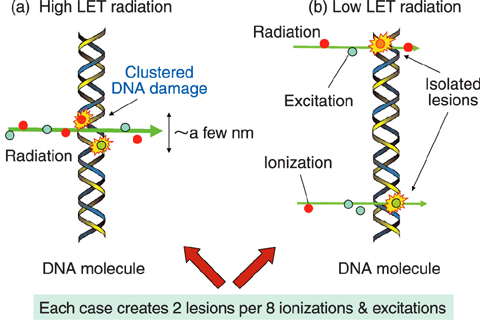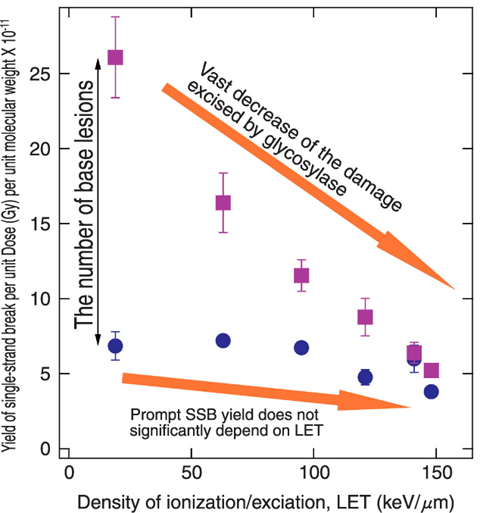
Fig.6-11 Induction of DNA damage by ionizing radiation

Fig.6-12 Dependence of frequency of DNA damage induction on ionization & excitation density of radiation track
Many chemical modifications are frequently produced in the genomic DNA (DNA damage) by ionizing radiation from its environment, such as radiation from radioactive materials in soil or cosmic radiation from space. Living systems, on the other hand, have through evolution developed several enzymatic DNA repair systems, which efficiently remove this damage from DNA to maintain the genomic code. If this damage is not repaired in a cell, it may cause serious genetic changes such as mutations, which may lead to cancer. The object of our study is to clarify the nature of damage, which is difficult for the repair enzymes to repair.
It has been proposed that radiation produces multiple lesions within a few nm in DNA molecules, so-called clustered DNA damage (Fig.6-11(a)). This densely localized damage might distort the tertiary structure of DNA and consequently interfere with the binding of repair enzymes to the damage site. Previous measurements of the damage yield (damage per unit dose) using chemical analysis, however, have not distinguished clustered damage from isolated lesions produced by radiation (Fig.6-11).
To investigate the interference of clustered damage with repair enzymes, we observed the damage repair by a repair enzyme. A DNA sample irradiated with He ion beams was mixed with a DNA repair enzyme, glycosylase, and kept at 37 °C for 30 min. This enzyme specifically excises damaged base moieties from DNA and then cuts the DNA strand at the damaged site (single-strand break (SSB)). The frequency of the enzymatically induced SSB was analyzed using a gel electrophoresis method. The density of lesion in a cluster is predicted to strongly depend on the number of ionizations and excitations along the He ion track (linear energy transfer (LET)) in the sample. The LET of the He ion beam was systematically changed to determine the LET dependence of the number of the enzymatically induced SSB.
Fig.6-12 shows the obtained yield of the enzymatically induced SSB plotted together with the yield of SSB directly induced by irradiation. The yield of SSB produced by the glycosylase drastically decreases with the increase of LET. This result indicates that higher LET radiation efficiently causes cluster-types of DNA damages, so that the repair activity of the enzyme is strongly inhibited. On the other hand, the yield of the promptly induced SSB by irradiation, which has been used as one of the standards of DNA damage, does not exhibit significant LET dependence (Fig.6-12). The enzymatic "probes" reveal that the yield of this DNA damage strongly depends not only on LET but also the types of particles of radiation, ions or photons (Yokoya, A., Invited Talk at the IXth International Workshop on Radiation Damage to DNA, 2006). These results are important for various fields of applied radiation science, such as risk-assessment of radiation or radiation-surgery on cancer.
<Previous: 6-4 | Next: 7 Nuclear Science and Engineering Research >